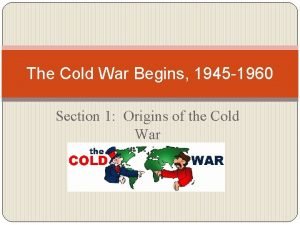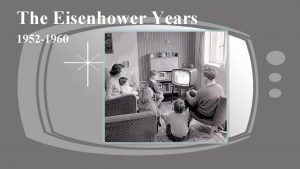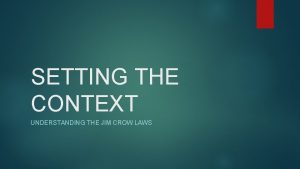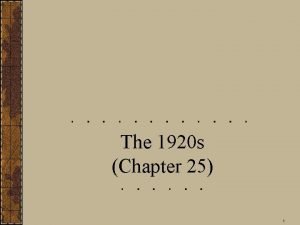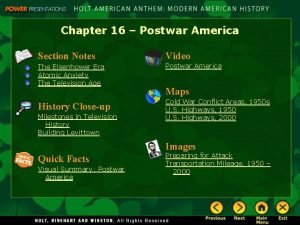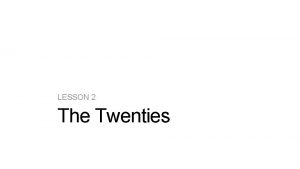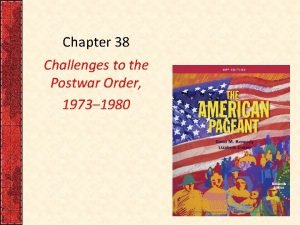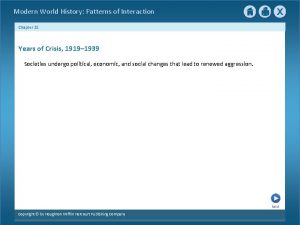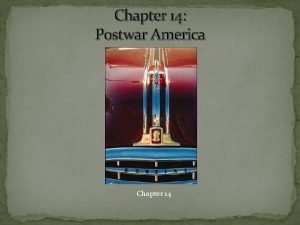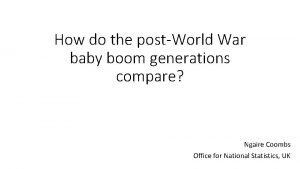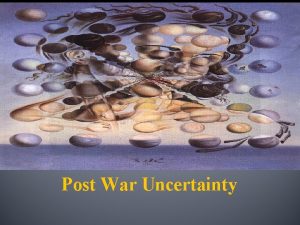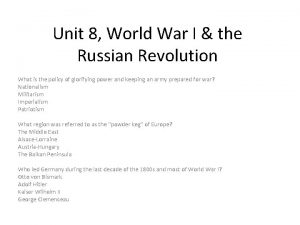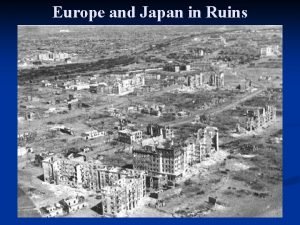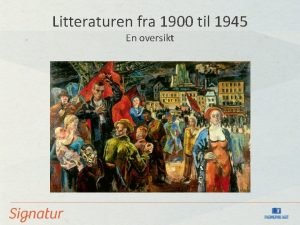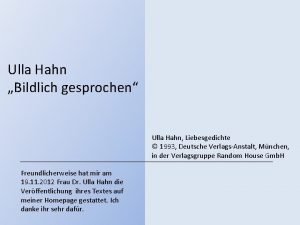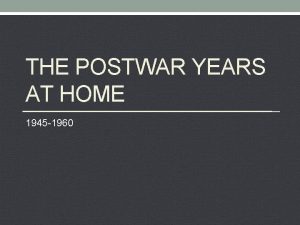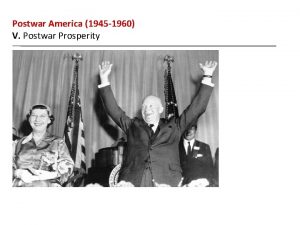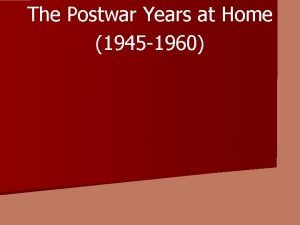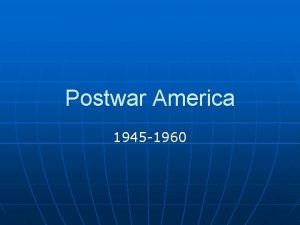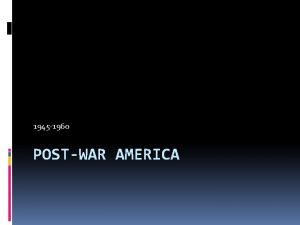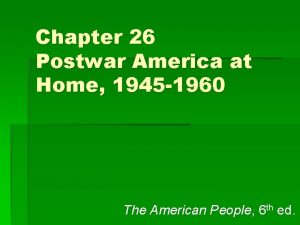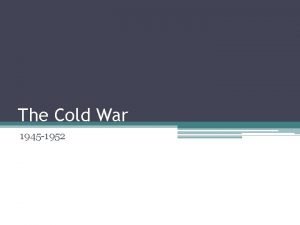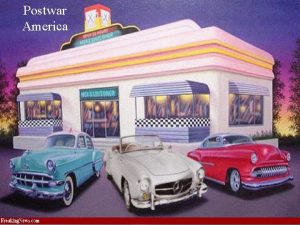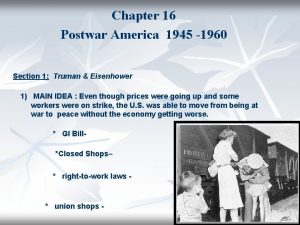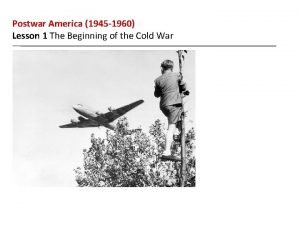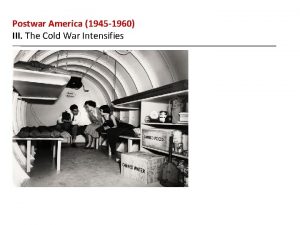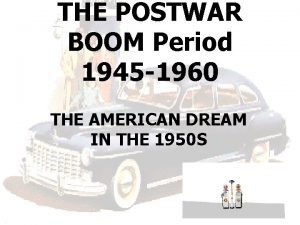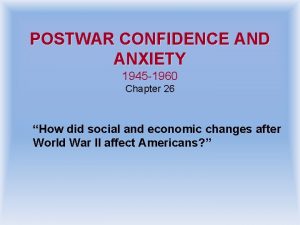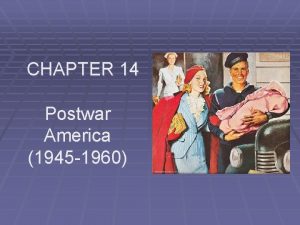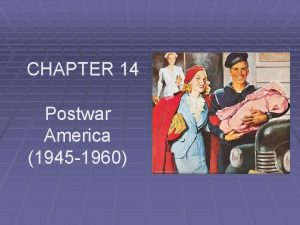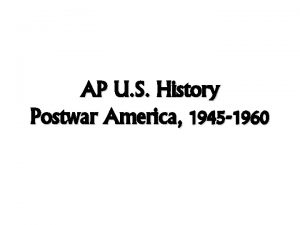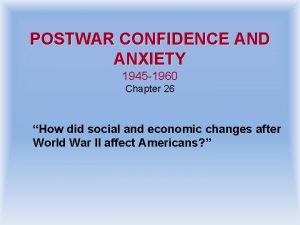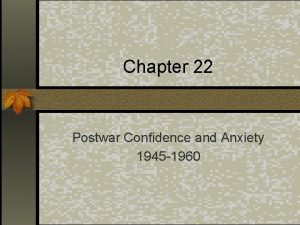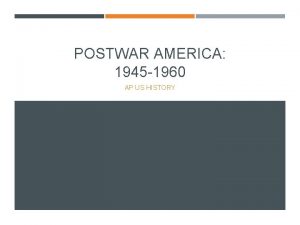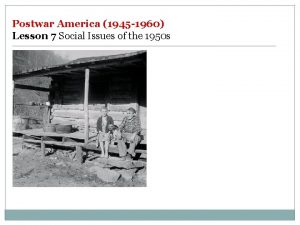The Postwar Years at Home 1945 1960 Setting









































































- Slides: 73

The Postwar Years at Home 1945 - 1960

Setting the Scene Returning soldiers wanted to get on with their lives. n Women had “nest eggs” n STRONG desire for consumer goods and homes. n

Setting the Scene Marriage rate skyrocketed n Baby boom n Suburbs boomed n By 1960 n n n 75% owned a car 80% had television

Businesses Reorganize GDP BOOMED! n Per capita Income increased n Industries quickly switched from war goods to consumer goods n

Industries Make Changes n The growth of conglomerates and corporations. n Less family owned businesses

Growth of Restaurants The Birth of Fast Food n The birth of the franchise n

Technology Transforms Life TELEVISION! n By 1955 families watched 4 – 5 hours of tv a day. n

Favorite Shows: n I Love Lucy!

Favorite Shows n Father Knows Best

Favorite Shows n Leave It To Beaver

Favorite Shows n Howdy Doody

Favorite Shows n The Mickey Mouse Club

Favorite Shows n American Bandstand

Television n ONLY 3 networks on until 1970. n n n CBS NBC ABC

The Computer Industry n Grace Hopper (Admiral) pioneered the first computers n Invented the term “debugging”

The invention of the TRANSISTOR First circuit device that amplifies, controls and generates electrical signal. n Didn’t take as much space. n

Nuclear Power n Ideas that nuclear power would be part of everyday lives. n n Nuclear wallpaper Nuclear children’s toys

Advances in Medicine 1954 - Dr. Jonas Salk: Polio Vaccine n Penicillin – the first antibiotic n Improvements in surgery n

Changes in the Work Force n 1940: n n n 55. 2% workers blue collar 44. 8 white collar workers 1960: n n 56. 2% white collar workers 43. 8% blue collar workers

White Collar Worker Drawbacks n n n Often impersonal Less connection with products and services Employees felt pressure to dress, think and act alike

Suburbs and Highways n The Baby Boom n n 1940 s’ – 19 births per 1, 000. 1957 30 births per 1, 000! n Baby Boom Generation 1945 1963

Moving to the Suburbs n n With growing families With new prosperity Families wanted to live more “nuclear” Families wanted “modern” housing.

Moving to the Suburbs Families wanted ranch-style houses. n Quickly assembled tract homes for the growing demand. n

Cars and Highways n To follow customers, downtowns moved to strip malls closer to the suburbs.

Cars and Highways Public transportation often didn’t reach to the suburbs. n More demand for cars. n Cars were status symbols (were? ) n

Cars and Highways 1950 s – auto makers began to do yearly models with new and improved features. n 1948 – 1958 car sales went up 50% n

Growth of the Car Culture People wanted to travel n 1956 – the Federal Highway Act, started the interstate system through the country. n n I – 80 in Nebraska completed in 1968

Little Known Fact About Interstates n Bigger lanes were meant for quicker evacuation of cities in case of nuclear attack and quicker movement of military equipment.

Car Culture created changes: n n Gas Stations Drive-in Movies Drive-in restaurants. Urged people to take trips and see the USA.

Growth of Consumer Credit The birth of the credit card! n Counter checks n

The Mood of the 1950 s n Comfort and security. n After the insecurities and “doing without” in the Depression and WWII – people didn’t want conflict.

The Mood of the 1950 s Americans encouraged conformity as a way of achieving harmony between individuals and groups. n Compromise over conflict was the motto n

Comfort and Security: Tootle the Engine Children’s book n Powerful parable “Always stay on the track no matter what. ” n n Tootle the little engine in “Engineville”

Youth Culture: The Silent Generation Little interest in the problems and crises of the world. n Strong economy allowed more teens to stay in school rather than leaving to find jobs. n

Youth Culture: The Silent Generation Students had more leisure time to be in sororities / fraternities. n Lots of parties n

Youth Culture: The Silent Generation n Advertising and movies built an image of how teens should look. n n Bobby socks Poodle skirts Letter sweaters “Clean cut” teens

Teen Girls: Conformity n About the only acceptable jobs for teen girls was babysitting. n n With the Baby Boom there were LOTS of jobs. Building their “Hope Chests” n Cabinets for things they would need as brides or new wives. – Silver, linens, and bridal stuff

Resurgence in Religion Church attendance was up. n Was it in response to “godless communism”? n Was it to protect against nuclear war? n

Resurgence in Religion n n Dial-a-Prayer phone lines “The Family that prays together, stays together. ” Televangelists like Billy Graham 1959 – 95% of Americans said they felt connected to formal religious groups

Government in Religion 1954 – “Under God” added to the Pledge of Allegiance n 1955 – “In God We Trust” added to our money. n n Felt it would show us who the Communists were.

Men’s and Women’s Roles n Men n Go to school, find a job, support the wife and children. Earn the money and make important political, economical, and social decisions. Be part of the world

Men and Women’s Roles n Play a supporting role to husband’s life. n n n Keep house Cook meals Raise children Hostess Do volunteer work n PTA, Campfire Girls, etc.

Challenges to Conformity n Social conformity made it easy to mask the differences among individuals and groups. n Ethnicity was discouraged.

Women at Work n Not all women left the workforce when they got married. n n 1950 – 24% of workforce was women 1960 – 31% was women.

Women at Work n Accepted in traditional jobs n Secretaries, teachers, nurses and sales clerks

“Typical” Woman in 1950 s n n Woman married at 16 4 children Kept busy with PTA, Campfire Girls, charity causes Home manager, mother, hostess and useful civic worker.

Challenges to Conformity Betty Friedan “The Feminine Mystique” n 1963 n First voice to say women were frustrated with their roles in the 1950 s. n

“The Feminine Mystique” n “It was unquestioned gospel that women could identify with nothing beyond the home – not politics, not art, not science, not events large or small, unless it could be approached through female experience as a wife or mother or translated into domestic detail. ” n Betty Friedan

Youthful Rebellions: Not every train was on the track! n Rebel Without a Cause – n n James Dean became a symbol of rebellion Catcher in the Rye – n Holden Caulfield troubled by “phonies” around him.

The Birth of Rock and Roll! n Alan Freed – DJ in Cleveland Ohio in 1951. n n Came up with the description of a new type of rhythm and blues sound. RADICAL! He played both black and white musicians.

Rock and Roll Legends n Chuck Berry

Rock and Roll Legends n Little Richard

Rock and Roll Legends n Fats Domino

Rock and Roll Legends n Bill Haley and the Comets

Rock and Roll Legends n Jerry Lee Lewis

Rock and Roll Legends n. ELVIS!!!

Society’s Reactions to the “devil’s music” in the 1950 s? Feared it would lead to immorality. n Caused a mixing of the races! n n Kids of different races going to the same concerts and buying the same records!

The Beatniks n n n “Beat Generation” Writers, artists, groupies. Encouraged spontaneity and no planning of anything. Open sexuality Thought that money and property was too controlled by the rich.

The Beatniks: Jack Kerouac On the Road (1957) Written in a month One continuous roll of paper. “Stream of consciousness” style of writing. Wild form

The Beatniks: Allen Ginsberg n Epic poem “HOWL” n “I saw the best minds of my generation destroyed by madness …”

Domestic Politics in the 1950 s n Two Presidents: n n Harry Truman (Democrat) Dwight “Ike” Eisenhower (Republican)

Harry Truman Took over after FDR. n “The buck stops here. ” n

Surprise Re-Election in 1948 “To err is Truman. ” n No one expected him to win! n But he did. n n Started some desegregation. Busy with Korean War after 1950. Was he an FDR Democrat or a believer in state’s rights?

1952 – 1960: Ike Eisenhower Former Supreme Commander of Allied Forces in WWII. n “A president must save himself the three or four big decisions he makes a year. ” n

“I Like Ike” Campaign slogan n “New” Republicanism: Conservative with money, liberal with human rights.

Eisenhower First to end segregation of troops. n First to send in the National Guard to desegregate Little Rock, Arkansas schools. n

Eisenhower: The Arms Race n Despite trying to balance the budget – he saw one of the greatest expansions of the military to fight the Cold War.

Eisenhower n Created NASA and the Space Race to keep space from going “Commie. ” n Made the decision that test pilots would be the best for being astronauts.

Let us not forget Eisenhower’s Vice President! n He was in trouble even then!

“The Checkers Speech” Richard Nixon was accused of having a secret money account to pay for his campaigning. n He didn’t, but the public believed it. n Eisenhower told him to save himself if he could. n

The Checkers Speech On television Nixon said the only gift he had ever accepted was for the family dog. n “My wife, Pat, wears a respectable Republican cloth coat. ” n

The public bought it. n It was Eisenhower and Nixon in 1952 and 1960.

Note: It is still Eisenhower and Nixon today. n Ike’s grandson and Nixon’s daughter are married.
 The cold war begins 1945-1960
The cold war begins 1945-1960 The eisenhower years, 1952-1960
The eisenhower years, 1952-1960 Sheep years to human years
Sheep years to human years 300 solar years to lunar years
300 solar years to lunar years How long is four score years
How long is four score years Softly and tenderly jesus is calling
Softly and tenderly jesus is calling She said that, home economics stands for the ideal home.
She said that, home economics stands for the ideal home. Perbedaan home care dan home visit
Perbedaan home care dan home visit New mobile home sales oak springs mobile home community
New mobile home sales oak springs mobile home community Home sweet home survive
Home sweet home survive Mobile home parks for sale in sc
Mobile home parks for sale in sc Let's go to my house
Let's go to my house Unit 1 home sweet home
Unit 1 home sweet home Arman home sweet home
Arman home sweet home Home care
Home care Understanding jim crow (setting the setting)
Understanding jim crow (setting the setting) Chapter 14 postwar prosperity and civil rights
Chapter 14 postwar prosperity and civil rights Chapter 16 postwar america
Chapter 16 postwar america Postwar issues lesson 2
Postwar issues lesson 2 Chapter 38 challenges to the postwar order
Chapter 38 challenges to the postwar order Chapter 15 section 1 postwar uncertainty
Chapter 15 section 1 postwar uncertainty Lesson 1 truman and eisenhower
Lesson 1 truman and eisenhower Postwar baby boom
Postwar baby boom Chapter 31 section 1 guided reading postwar uncertainty
Chapter 31 section 1 guided reading postwar uncertainty American struggle with postwar issues
American struggle with postwar issues Levittown apush
Levittown apush What was trench warfare intended to accomplish
What was trench warfare intended to accomplish Chapter 19 section 1 postwar america
Chapter 19 section 1 postwar america How did postwar disillusionment contribute to
How did postwar disillusionment contribute to Note three political problems postwar governments faced
Note three political problems postwar governments faced Thế nào là hệ số cao nhất
Thế nào là hệ số cao nhất Ng-html
Ng-html Hệ hô hấp
Hệ hô hấp Tư thế ngồi viết
Tư thế ngồi viết Các số nguyên tố
Các số nguyên tố đặc điểm cơ thể của người tối cổ
đặc điểm cơ thể của người tối cổ Các châu lục và đại dương trên thế giới
Các châu lục và đại dương trên thế giới Mật thư tọa độ 5x5
Mật thư tọa độ 5x5 Chụp phim tư thế worms-breton
Chụp phim tư thế worms-breton ưu thế lai là gì
ưu thế lai là gì Thẻ vin
Thẻ vin Cái miệng xinh xinh thế chỉ nói điều hay thôi
Cái miệng xinh xinh thế chỉ nói điều hay thôi Các châu lục và đại dương trên thế giới
Các châu lục và đại dương trên thế giới Bổ thể
Bổ thể Từ ngữ thể hiện lòng nhân hậu
Từ ngữ thể hiện lòng nhân hậu Tư thế ngồi viết
Tư thế ngồi viết Ví dụ giọng cùng tên
Ví dụ giọng cùng tên Thơ thất ngôn tứ tuyệt đường luật
Thơ thất ngôn tứ tuyệt đường luật Làm thế nào để 102-1=99
Làm thế nào để 102-1=99 Chúa yêu trần thế alleluia
Chúa yêu trần thế alleluia Hổ sinh sản vào mùa nào
Hổ sinh sản vào mùa nào Diễn thế sinh thái là
Diễn thế sinh thái là đại từ thay thế
đại từ thay thế Vẽ hình chiếu vuông góc của vật thể sau
Vẽ hình chiếu vuông góc của vật thể sau Công thức tính độ biến thiên đông lượng
Công thức tính độ biến thiên đông lượng Tỉ lệ cơ thể trẻ em
Tỉ lệ cơ thể trẻ em Thế nào là mạng điện lắp đặt kiểu nổi
Thế nào là mạng điện lắp đặt kiểu nổi Lời thề hippocrates
Lời thề hippocrates Vẽ hình chiếu đứng bằng cạnh của vật thể
Vẽ hình chiếu đứng bằng cạnh của vật thể độ dài liên kết
độ dài liên kết Quá trình desamine hóa có thể tạo ra
Quá trình desamine hóa có thể tạo ra Các môn thể thao bắt đầu bằng tiếng nhảy
Các môn thể thao bắt đầu bằng tiếng nhảy Hình ảnh bộ gõ cơ thể búng tay
Hình ảnh bộ gõ cơ thể búng tay Khi nào hổ mẹ dạy hổ con săn mồi
Khi nào hổ mẹ dạy hổ con săn mồi Dot
Dot điện thế nghỉ
điện thế nghỉ Nguyên nhân của sự mỏi cơ sinh 8
Nguyên nhân của sự mỏi cơ sinh 8 Trời xanh đây là của chúng ta thể thơ
Trời xanh đây là của chúng ta thể thơ Chó sói
Chó sói Thiếu nhi thế giới liên hoan
Thiếu nhi thế giới liên hoan Tia chieu sa te
Tia chieu sa te Một số thể thơ truyền thống
Một số thể thơ truyền thống Krigslyrikk
Krigslyrikk Ulla hahn bildlich gesprochen interpretation
Ulla hahn bildlich gesprochen interpretation
